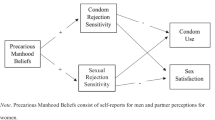Abstract
Those who are rejection sensitive anxiously expect and readily perceive rejection. Rejection sensitivity is hypothesized to predict behavior; however, this link may be more evident in some contexts than others. The current study examined the link between rejection sensitivity and condom use. Australian young adults in romantic (n = 649, 70% female) and casual (n = 144, 76.2% female) relationship contexts completed measures on rejection sensitivity, condom use preferences, and condom use. Regression analysis showed that rejection sensitivity predicted condom use when participants’ condom use preferences were at odds with those they thought their partner held. Specifically, highly rejection-sensitive individuals who preferred more frequent condom use reported using condoms less often, if that was what they thought their partners wanted. The results lend support to the model of rejection sensitivity in that individuals comply more with their perceived partner’s preferences if they are more rejection-sensitive. The results also highlight the need to take the situational context into consideration when examining links between personality dispositions and behavior.
Similar content being viewed by others
References
Ajzen, I. (1991). The theory of planned behavior. Organizational Behavior and Human Decision Processes, 50, 179–211.
Amaro, H. (1995). Love, sex, and power: Considering women’s realities in HIV prevention. American Psychologist, 50, 437–447.
Bogaert, A. F., & Sadava, S. (2002). Adult attachment and sexual behavior. Personal Relationships, 9, 191–204.
Bromnick, R., & Swinburn, P. (2003). Young people’s social representations of a sexual experience. Journal of Adolescence, 26, 375–379.
Collins, N. L., & Read, S. J. (1990). Adult attachment, working models, and relationship quality in dating couples. Journal of Personality and Social Psychology, 58, 644–663.
Crockett, L. J., Raffaelli, M., & Moilanen, K. L. (2003). Adolescent sexuality: Behavior and meaning. In G. R. Adams & M. D. Berzonsky (Eds.), Blackwell handbook of adolescence (pp. 371–392). Malden, MA: Blackwell Publishing.
Downey, G., Bonica, C., & Rincon, C. (1999). Rejection sensitivity and adolescent romantic relationships. In W. Furman, B. B. Brown, & C. Feiring (Eds.), The development of romantic relationships in adolescence (pp. 148–174). New York: Cambridge University Press.
Downey, G., & Feldman, S. I. (1996). Implications of rejection sensitivity for intimate relationships. Journal of Personality and Social Psychology, 70, 1327–1343.
Edwards, G. L., & Barber, B. L. (2009). Women may underestimate their partners’ desires to use condoms: Possible implications for behaviour. Journal of Sex Research. doi:10.1080/00224490902867863.
Ellen, J. M., Cahn, S., Eyre, S. L., & Boyer, C. B. (1996). Types of adolescent sexual relationships and associated perceptions about condom use. Journal of Adolescent Health, 18, 417–421.
Feeney, J. A., Kelly, L., Gallois, C., Peterson, C., & Terry, D. J. (1999). Attachment style, assertive communication, and safer-sex behavior. Journal of Applied Social Psychology, 29, 1964–1983.
Feeney, J. A., Peterson, C., Gallois, C., & Terry, D. J. (2000). Attachment style as a predictor of sexual attitudes and behavior in late adolescence. Psychology & Health, 14, 1105–1122.
Festinger, L. (1957). A theory of cognitive dissonance. Oxford: Row, Peterson.
Furman, W., & Simon, V. A. (1999). Cognitive representations of adolescent romantic relationships. In W. Furman, B. B. Brown, & C. Feiring (Eds.), The development of romantic relationships in adolescence (pp. 75–98). New York: Cambridge University Press.
Gebhardt, W. A., Kuyper, L., & Greunsven, G. (2003). Need for intimacy in relationships and motives for sex as determinants of adolescent condom use. Journal of Adolescent Health, 33, 154–164.
Juarez, F., & Martín, T. C. (2006). Safe sex versus safe love? Relationship context and condom use among male adolescents in the Favelas of Recife, Brazil. Archives of Sexual Behavior, 35, 25–35.
Kershaw, T. S., Milan, S., Westdahl, C., Lewis, J., Rising, S. S., Fletcher, R., et al. (2007). Avoidance, anxiety and sex: The influence of romantic attachment on HIV-risk among pregnant women. AIDS and Behavior, 11, 299–311.
Mischel, W., & Shoda, Y. (1995). A cognitive-affective system theory of personality: Reconceptualizing situations, dispositions, dynamics, and invariance in personality structure. Psychological Review, 102, 246–268.
Noar, S. M., Cole, C., & Carlyle, K. (2006). Condom use measurement in 56 studies of sexual risk behavior: Review and recommendations. Archives of Sexual Behavior, 35, 327–345.
Rosenthal, D. A., Hall, C., & Moore, S. M. (1992). AIDS, adolescents, and sexual risk taking: A test of the Health Belief Model. Australian Psychologist, 27, 166–171.
Sheeran, P., Abraham, C., & Orbell, S. (1999). Psychosocial correlates of heterosexual condom use: A meta-analysis. Psychological Bulletin, 125, 90–132.
Young, B. J., & Furman, W. (2008). Interpersonal factors in the risk for sexual victimization and its recurrence during adolescence. Journal of Youth and Adolescence, 37, 297–309.
Author information
Authors and Affiliations
Corresponding author
Appendix
Appendix
Definitions of relationship types presented to participants
Rights and permissions
About this article
Cite this article
Edwards, G.L., Barber, B.L. The Relationship Between Rejection Sensitivity and Compliant Condom Use. Arch Sex Behav 39, 1381–1388 (2010). https://doi.org/10.1007/s10508-009-9520-8
Received:
Revised:
Accepted:
Published:
Issue Date:
DOI: https://doi.org/10.1007/s10508-009-9520-8




